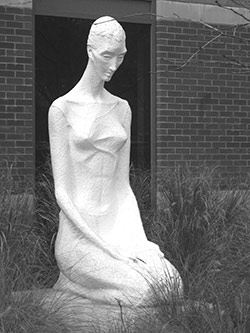A "Discovery" at Fanshawe College
 CREDIT: DAVID DIMITRIE
CREDIT: DAVID DIMITRIEFrances Gage's "Discovery of Hands" can be found outside of the F-Building.
For the past two years I’ve walked by a twice life-sized statue of a woman in a meditative pose, in front of F-Building on my way to the class. The nearby alcove, which is surrounded by the Hull Family Gardens, makes a peaceful home for this statue. The gardens and statue are a peaceful contrast to busy hallways and technology, which pervades every part of campus life.
An employee at the college told me that Internationally acclaimed Canadian sculptor Frances Gage had created the statue named “Discovery of the Hands.” It had been created for the Ontario Vocational Centre, London three years before Fanshawe College existed. It was delivered to the London campus in 1964, placed in an impressive pool/ plaza closer to Oxford Street where the College President’s office was once located.
In 2007, the statue was relocated and rededicated by former college President Howard Rundle in its present location in front of F-Building.
Gage attended the rededication. Photos of her and “Discovery of the Hands” can be seen in Richard Bain’s Photo Book of Fanshawe College in the college library. It’s understandable why so few students know much about the sculpture in its present location. However, 2014 would have been the 50th year that “Discovery of the Hands” has been on our campus.
Gage is now 90 years old.
In 2007, Gage said “Discovery of Hands” symbolized “strength, spirituality and connectedness through different media.” In 2009, Alan D. Butcher completed a biography of Frances Gage, which gives greater insight into her life and the hundreds of works that she completed in her lifetime, such as “The Woman,” which was unveiled in 1972 by former Prime Minister Pierre Elliot Trudeau in the foyer of Women’s College Hospital in Toronto.
Gage was born in Windsor, ON in 1924. In her early years, her creative but nurturing personality came through as she spoke of her brother and sisters and the cats and dogs that she longed to adopt. Later in life, she would seldom be without one as a loyal companion, and she spoke of an earlier desire to study veterinary medicine.
In an email interview, she spoke of her love of playing in the mud in the Chedoke Creek near Hamilton, when her family made the move to the area. She said that these times as a child helped awaken her creativity and spark her life’s work. Gage made the most of the opportunities that came to her, throughout her life.
We often hear about lack of opportunities for young adults today. Was it any easier over 60 years ago when Gage was able to realize a dream and enter the Ontario College of Art? She served several years in the Women’s Royal Canadian Naval Service (WRENS) during the final years of the Second World War and for several years afterwards when she worked for little pay on a failed attempt to design a new Canadian flag?
She was admitted to the Ontario College of Art in Toronto in part because of her military service as a WREN. The friends she made and the skills she learned at OCA continued throughout her entire life. A statue stands today, in front of the Cambridge Central Library, which Gage created in honour of all the WRENS during the Second World War. It was dedicated in 1972 and it is called “The Jenny.”
Gage went on to study in New York and in Paris at L’école des beaux arts through scholarships, work and assistance from patrons of the arts. Again, Gage made the most of her opportunities.
While Gage sculpted such famous pieces as “The Woman” still on display in Woman’s College Hospital, “Jenny,” “Discovery of Hands,” “Rosamund” and hundreds more, she should be known as person too. The artist, the sister, the daughter, the friend, the businesswoman and the stubborn creator cannot be separated. They are unified, like a body of work.
Gage had a natural ability to make deep lifelong friends. In Butcher’s Unlikely Paradise: The life of Frances Gage he notes: “Frances was unconsciously good at meeting and making them friends without being aware of it. She was a world-class networker before the word networking became current.”
Today, Gage is quite content. She lives in Cobourg and as usual she still has many friends. She still tutors, teaches, sketches, paints, sculpts and creates. In her words, “if you stop your creative insight, you will fade away and die.” I believe she meant those words for students in all fields of study.
Take a look at Gage’s sculpture the next time you go by F-Building. Gage’s spirit is still in its design and meaning. She once said about “Discovery of the Hands,” that “my intention was to bring a sense of peace; meditation for peace if you will.”













